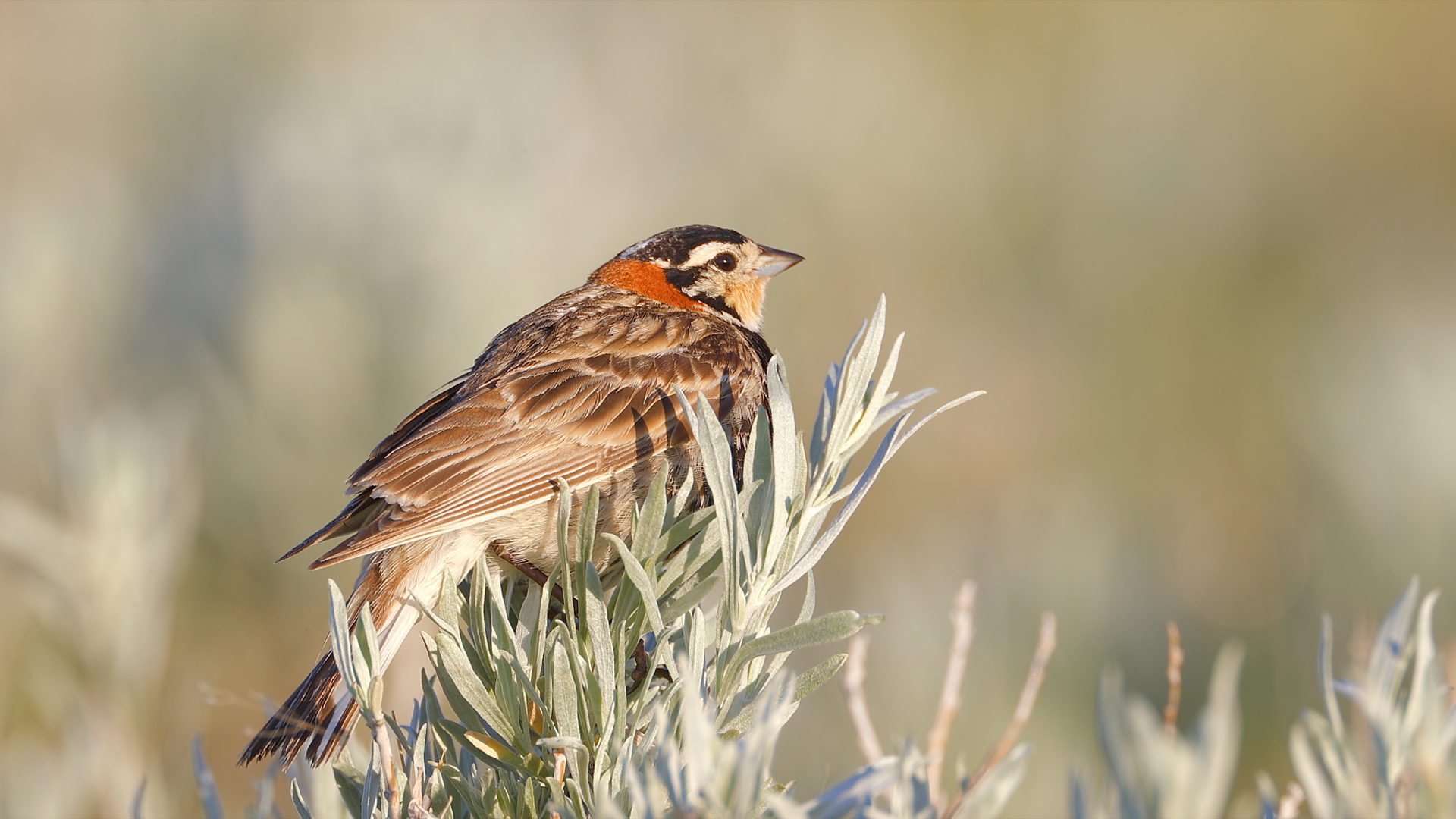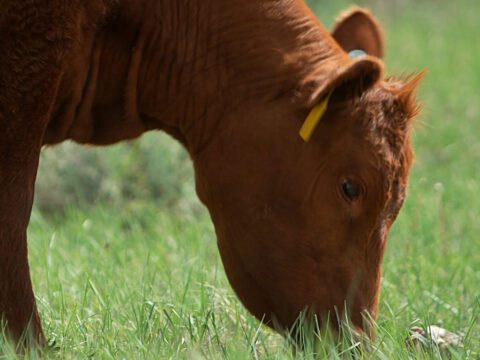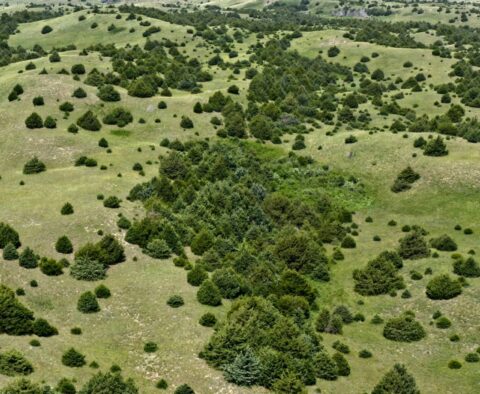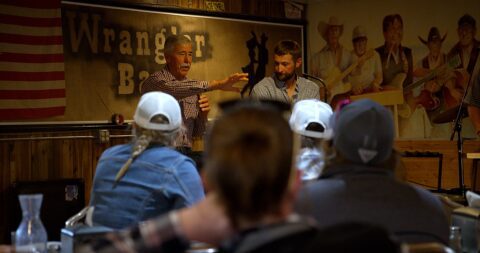“Vital Signs”
Monitoring for the Bird and the Herd
Monitoring grassland birds in South Dakota to determine how changes in cattle grazing methods are improving ecosystem health.

If we look at the largest conservation challenges we face anywhere in the world, they all have a huge human dimension to them. Science is useless if you don’t engage the people who work and actually use that science on the ground.
Brandt Ryder, Bird Conservancy of the Rockies
Chestnut-collared Longspur
Yeah, we’re pretty much just going to go straight this way. Almost 500 meters. So we’ve got some walking to do. We should get started.
The Lamont property is part of this National Fish and Wildlife Foundation Effectiveness Monitoring Project, where they have implemented a grazing management plan. So we’re out here monitoring how effective it’s been for some birds.
So I’m just recording my beginning information for the survey. We record the start time, sky conditions. This is kind of a quick and dirty vegetation survey. We’re birders, so we do our best with the veg, but you know, we’re not …
It’s not that bad right now. You’ve got more diversity, I would say. Short stuff, more species. These little guys down here.
There’s just a lot more structure in the grass. And I’ve also noticed that when we got into where there’s a more structure in the grass, you start hearing Grasshopper Sparrows more.
It’s probably the most common one we see.
Yeah, there’s one over there. There’s one over there. One over there. Like they’re all around us.
So I’m done with the veg. I’m going to go ahead and do the bird point count. So what I’ll do is I’ll start my timer and it’ll go for 6 minutes. And during that 6 minutes, I’m just going to be recording everything that I see in hear.
So we just want to be nice and quiet, and then we’ll start in 3 to 1.
Bird Conservancy, specifically, is focusing on grasslands bird species, since they’re having such drastic declines.
Motus is a worldwide network of automated radio telemetry stations. The network is essentially made up of these receiver stations coupled with tagged animals.
Cables up, cables down?
Down
We put a little radio transmitter tag on an animal of interest – bats, insects, birds. And as they pass within roughly 15 to 20 kilometres of one of these receiver stations, a detection is made at the station.
So these cables are what is going to transmit our radio detections into our sensor station to collect the data from there. I’m very curious to see what we’re going to see out here.
All right. So we’re doing 240 first?
What?
240 first?
Sure. Yeah. That’s 240 ish.
Go ahead and aim it that way. Just just a tad. A little bit more. Right there. Perfect.
You have a hare behind you?
A hair?
Yeah.
I imagine it’s a spider web.
No, I mean, like the animal.
It’s a spider web.
Cool.
They’re going to be in a wall.
So you want to attach….?
But you just need one more?
Three? I think that’s enough, cause unless I’m …
Let’s see. One, two, three. Yeah, yeah, that’s enough.
We’re good at math.
Maybe statistical math. Not adding.
I suspect mist nets catch more people than they do birds.
That feels pretty good.
Nice move.
I think the challenges with grasslands is that the decline of this ecosystem is pretty far along and we have lost 70 to 90% of populations of some of these grassland bird species. If we look at the largest conservation challenges we face anywhere in the world, they all have a huge human dimension to them. Bird Conservancy is trying to embrace that and capture that. Science is useless if you don’t engage the people who are going to actually use that science on the ground.
The hope here is that we’re going to use this mist net – this is kind of pretty standard tool that we use to catch birds. The way these nets work is that there’s lots of extra netting and so when the bird flies in, they will fly in and get caught and hang down and they’re relatively easy to take out.
You guys are probably seeing this bird before, right?
Meadowlark
Yep, it’s a Meadowlark. So we’re going to just take some measurements. And the primary purpose of what we’re doing is to put this small radio transmitter on the Meadowlark’s back. And then any time she comes into close distance of one of these towers, then the tower will pick her up.
It’s almost like it weighs nothing, right?
Most of these grassland birds that we’re working on, they spend the summer here and then these guys migrate. They make a long distance trip. Some of these grassland birds will winter down in Texas and New Mexico, but others will go all the way down into Mexico. And these tags provide us information about where those birds are going. And we need to know that information to be able to protect these birds. If we don’t know where they spend their time. We can’t protect them.
So this is what the tag looks like then on the bird’s back. And this tag has a unique signal. And so once the bird is picked up by the station, that data is all going to a central location online. And you guys could get on your computer and actually see which birds came by your tower.
So is this going to stay on them their whole life?
This tag will stay on the bird for about a year. It’ll get stretched out and then it will fall off the bird. So it won’t be on it for the rest of its life.
Are you ready?
There she goes.
Is this an area that you normally graze?
We do, but we do fairly intensive rotation. So this is high intensity, short duration.
Having that variation in grass height is also super beneficial for grassland birds. So we know there are certain grassland birds that need that very short grass structure, things like Mountain Plover and some of the Longspurs. They they absolutely need that that more intense grazing pressure and then some rest and things like Grasshopper Sparrow and Baird’s Sparrow. They like a little bit taller grass. So it turns out that there’s this natural synergy between that rotational grazing practice and the diversity of grassland birds you have on the landscape.
When I was younger than these guys, probably, I just got interested in birds and lived out on the prairie all my life. And after you get so long in doing that, well, you get more interested in the grass and stuff too. And if you’re running cattle why you need to know those things, or you’re not going to be here very long, if you don’t take care of that stuff.
You really are the stewards of this landscape. Without the ranching community and the producer community, there will be no grass and birds.
Learning is a lifetime proposition, whether it be my dad or me or these guys. It just … If you’re not learning something every day, you’re not paying attention.
So this is a little Grasshopper Sparrow.
See it’s flown in on this side of the net. A beautiful little bird.
This is a grasshopper sparrow.
Oh, this is one?
I think we’re naturally curious, and we appreciate that there’s folks like you guys out there trying to study, trying to find out what’s creating loss, trying to save habitat. Most people realize that if you have a healthy bird population, everything else is healthy. Agriculturalists in general understand that everything works together. And if part of it isn’t healthy, you’re going to have other issues.
There you go.
And that’s time
I heard Western Meadowlarks. I counted five that were within, you know, 300 meters of us or so. Grasshopper Sparrows -one, two, three, four, five, six. Redwing blackbirds, a couple of those, and then Hornlark. Chestnut-collared Longspur and Upland Sandpiper, which I heard right there at the end. I mean, this is a classic suite of species for native or intact grassland.
I think it’s more of a healthy ecosystem. Cows seem to do really well on it. It’s a lot more tolerant. It can handle the really cold and dry more than like this tame stuff.
The benefit that you see with with the cattle, that results in a landscape that’s better for the birds as well. And that’s one of the things that we’re really interested in and that’s why we’re we’re out here.
End of Transcript
To enrich a scene showing a grassland bird’s capture and tagging, we used an animation explaining how tracking that bird across its full life cycle helps identify areas for protection.



